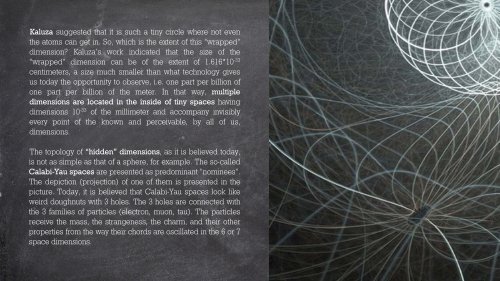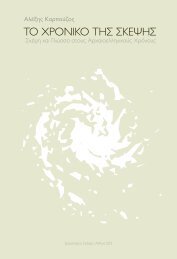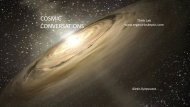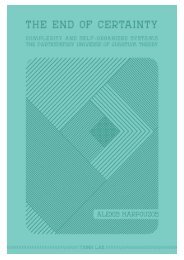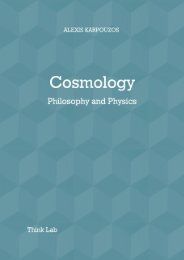THE 4TH DIMENSION IN ART AND SCIENCE - ALEXIS KARPOUZOS
A visual narrative of the relationship between science and art during the 20th century
A visual narrative of the relationship between science and art during the 20th century
You also want an ePaper? Increase the reach of your titles
YUMPU automatically turns print PDFs into web optimized ePapers that Google loves.
Kaluza suggested that it is such a tiny circle where not even<br />
the atoms can get in. So, which is the extent of this “wrapped”<br />
dimension? Kaluza’s work indicated that the size of the<br />
“wrapped” dimension can be of the extent of 1.616*10 -33<br />
centimeters, a size much smaller than what technology gives<br />
us today the opportunity to observe, i.e. one part per billion of<br />
one part per billion of the meter. In that way, multiple<br />
dimensions are located in the inside of tiny spaces having<br />
dimensions 10 -33 of the millimeter and accompany invisibly<br />
every point of the known and perceivable, by all of us,<br />
dimensions.<br />
The topology of “hidden” dimensions, as it is believed today,<br />
is not as simple as that of a sphere, for example. The so-called<br />
Calabi-Yau spaces are presented as predominant “nominees”.<br />
The depiction (projection) of one of them is presented in the<br />
picture. Today, it is believed that Calabi-Yau spaces look like<br />
weird doughnuts with 3 holes. The 3 holes are connected with<br />
the 3 families of particles (electron, muon, tau). The particles<br />
receive the mass, the strangeness, the charm, and their other<br />
properties from the way their chords are oscillated in the 6 or 7<br />
space dimensions.


